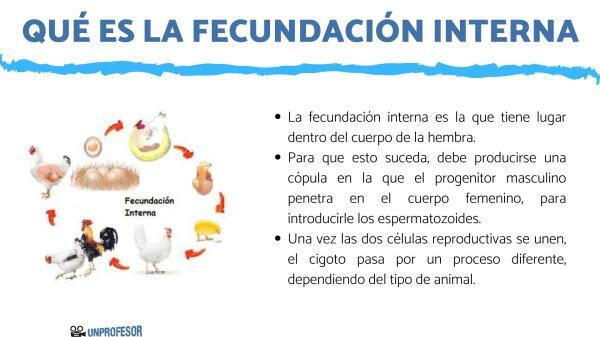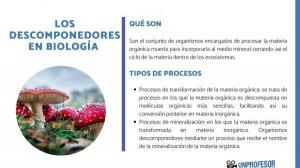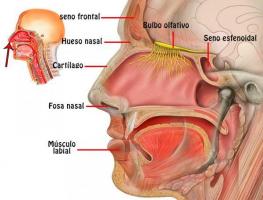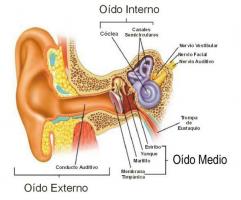What is INTERNAL fertilization and examples

The internal fertilization is the one that takes place inside the body of the female parent, in organs such as the uterus or similar. This type of fertilization occurs most frequently in land animals, although some aquatic animals also use this method.
In this lesson from a TEACHER, we are going to explain in detail what is internal fertilization, in addition to giving you some examples of living beings that reproduce in this way.
Index
- What is internal fertilization: easy definition
- Examples of internal fertilization in animals
- What is the internal fertilization process like?
- Advantages of internal fertilization
- Disadvantages of internal fertilization
What is internal fertilization: easy definition.
exist two types of fertilization in animals, depending on where the meeting of the reproductive cells occurs: internal and external fertilization. The external fertilization Is that which occurs in the environment, through the release of gametes from both parents. However, today we are going to focus solely on internal fertilization.
Internal fertilization is what takes place inside the female's body. For this to happen, copulation must occur in which the male parent penetrates the female body to introduce sperm. Once the two reproductive cells join together, the zygote goes through a different process, depending on the type of animal we are talking about.
Oviparous animals
The fertilized eggsthey are put outside the body from the female and develop there, receiving nourishment from the yolk that is part of the egg.
Ovoviviparous animals
The fertilized eggs are retained in the female, but the embryo obtains its nourishment from the yolk of the egg. When the babies are fully developed, the egg is expelled and they are born.
viviparous animals
The eggs begin to transform inside the female's body, receiving food through the mother's blood and the placenta. The animal develops completely inside the female's body and is born alive and prepared for the outside environment.

Examples of internal fertilization in animals.
Let's put some on you examples of animals with internal fertilization, among which we are ourselves:
- The human being
- Whales and dolphins
- Cats and dogs (all felines and canids)
- Squirrels, mice, rats, rabbits, guinea pigs and other rodents
- Cows, pigs and horses
- Elephants, rhinos and giraffes
- The birds
- The reptiles
- Some species of fish and amphibians.
Here we leave you the differences between internal and external fertilization.

What is the internal fertilization process like?
fertilization is the process in which reproductive cells or gametes fuse, coming from both parents. These cells will form a zygote, which will become a completely new individual. To achieve this, the male and female cells must come together and fuse the nuclei of their cells, mixing genetic material to form a new and whole being.
This is the stage that comes after intercourse, in which both individuals have released their gametes. For fertilization to occur, it is necessary that both parents are of the same species and that they are fertile. Depending on the species, this process can change; however, always includes these basic stages:
- Phase 1: The gametes connect. The sperm are attracted to the egg and move towards it, using their flagella. When they are found together, a chemical recognition occurs to see if they are compatible and if the minimum conditions exist for their union.
- Phase 2: Penetration of the egg: The penetration of the egg occurs thanks to its rupture, through a small deposit of hydrolytic proteins that each sperm has at the tip. When it enters the interior of the ovule, it leaves its flagellum outside. Typically, only one sperm manages to penetrate the egg.
- Phase 3: Fusion of the nuclei: When the two gametes are together, a reaction takes place, by which the sperm fuses its plasma membrane with that of the egg, allowing its contents to spread throughout the interior of this. The two cell nuclei, then, are found inside the egg. At that moment, a nuclear and genetic fusion occurs, in which each cell contributes half of the genome of each parent, to form a complete DNA of a new individual.
- Phase 4: The zygote is formed: When the nuclei are already fused, the zygote is ready to begin its growth and multiply its contents. In this way, a new individual begins to form, with its own cells. Here we tell you how the zygote is formed.
In this other lesson we discover the phases of internal fertilization.

Advantages of internal fertilization.
The internal fertilization process does not require the production and release of large quantities of sex cells, as happens with external fertilization. This implies a metabolic advantage, since there are many fewer resources that must be allocated to generate these gametes.
On the other hand, the contact and fusion of sex cells occurs inside the female, that is, a closed space. There, the pH, salinity and temperature conditions are constant, so it is an advantage for the success or survival of the offspring.
Disadvantages of internal fertilization.
On the other hand, one of the main disadvantages of the internal fertilization process is that the number of offspring produced is much smaller. That is evident from the point of view of the carrying capacity of the female, that she must develop her offspring within her structures.
Likewise, this type of fertilization, unlike what happens with external fertilization, implies a greater effort on the part of parents to find a partner. Contact between a male and a female is essential.
Another disadvantage is that the greatest participation falls on the females, since the nutrition of the young depends on them, through the placenta or the care of the eggs in the nests.
Finally, animals that reproduce internally usually require more parental care, than species that are born from external fertilization. Many times the offspring cannot care for themselves for quite long periods of time after birth.
Now you know what is internal fertilization and you have seen some examples that have helped you understand the content. If you want to continue learning more about the processes that living beings go through, do not hesitate to consult our biology section.
If you want to read more articles similar to What is internal fertilization - examples, we recommend that you enter our category of biology.
Bibliography
- Del Carmen, G. c. TO. Fertilization and implantation.
- Rodríguez, F. c. (2003). Bases of animal production (Vol. 61). Sevilla University.



